Performance Analysis of a Double-effect Adsorption Refrigeration Cycle with a Silica Gel/Water Working Pair
Abstract
:1. Introduction
2. Working Principle
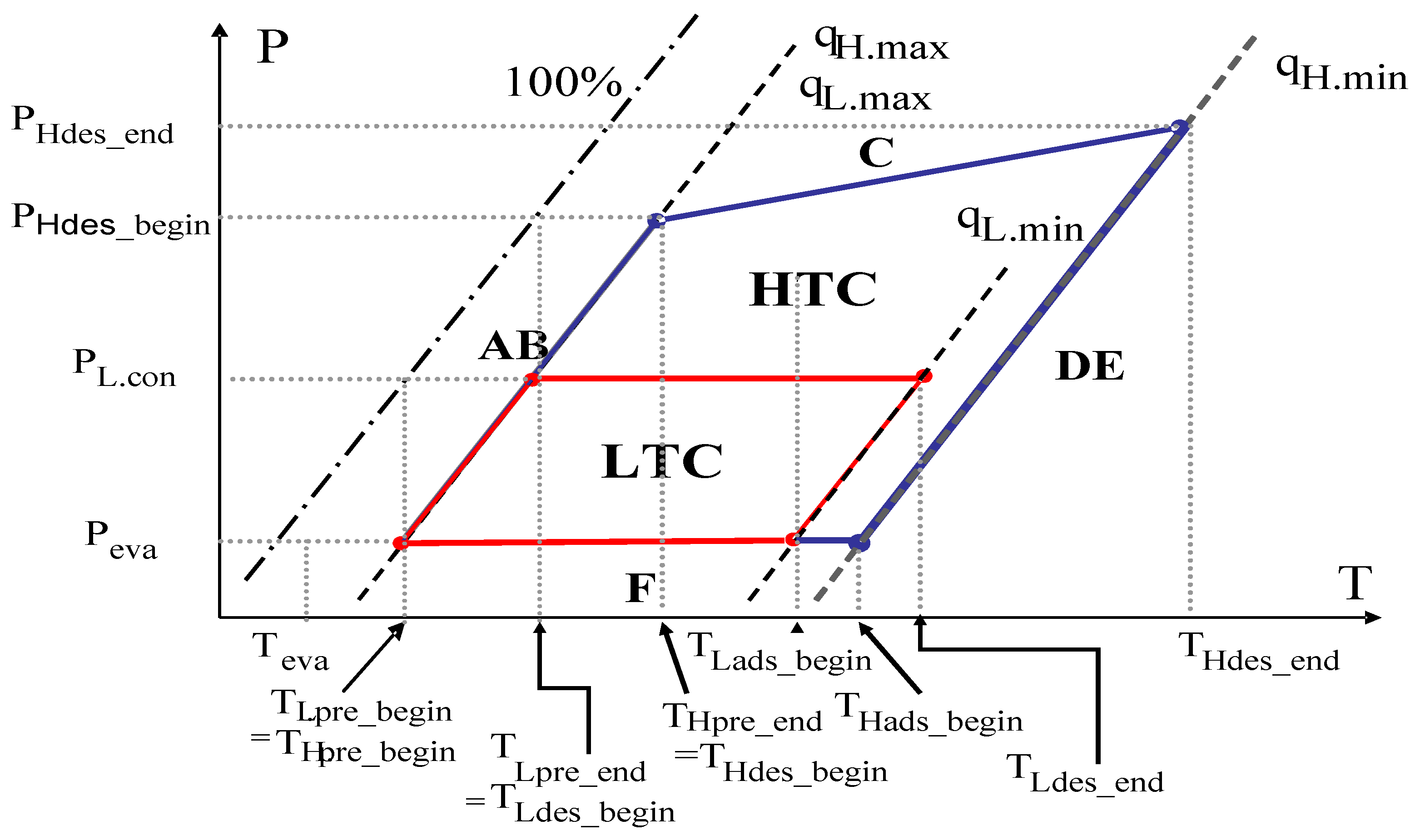
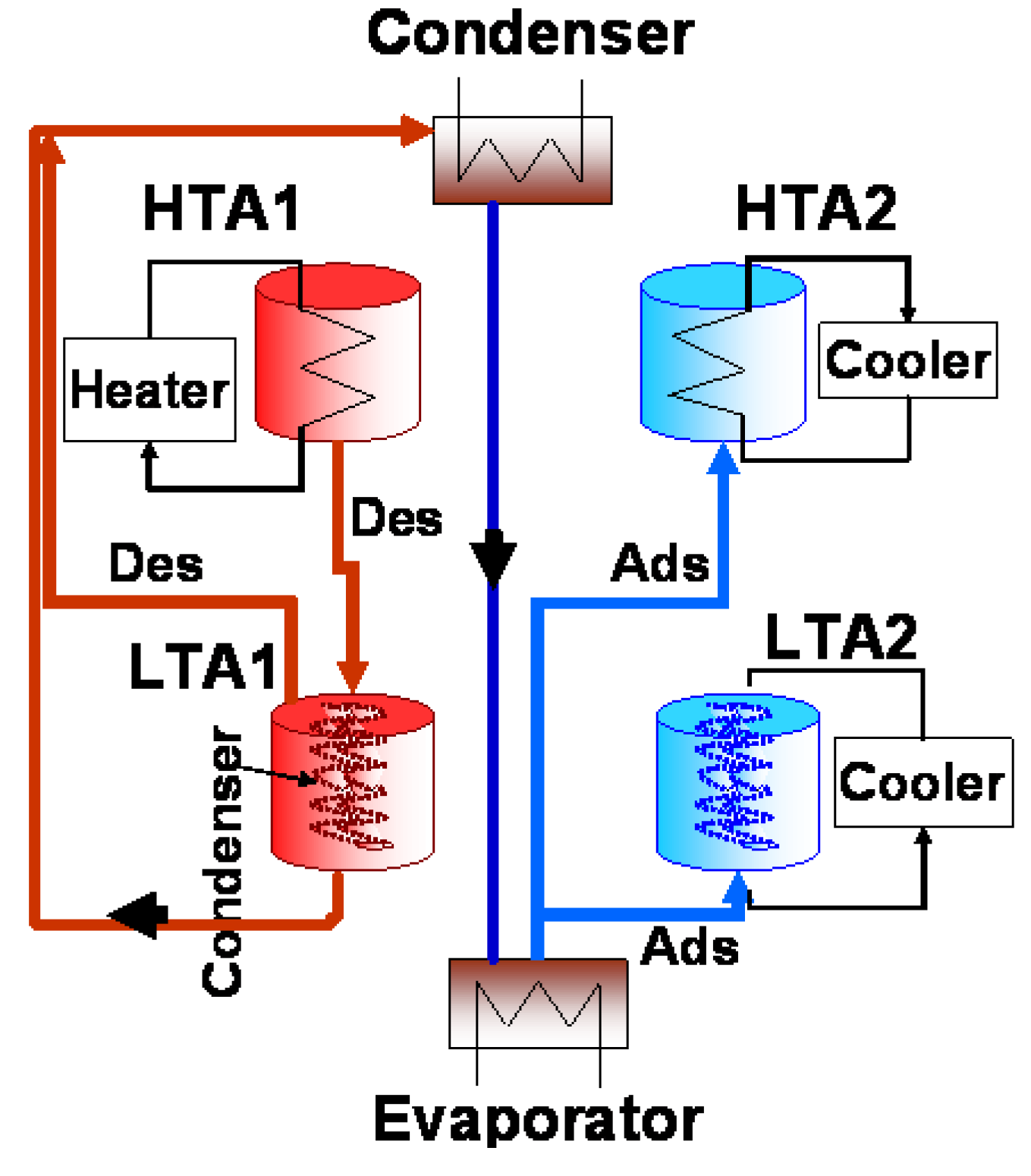

| Symbol | Value | Unit |
|---|---|---|
| Cs | 924 | Jkg−1K−1 |
| Cpw | 4.18E + 3 | Jkg−1K−1 |
| Cp,cu | 386 | Jkg−1K−1 |
| Cp,al | 905 | Jkg−1K−1 |
| Cpf | 2,090 | Jkg−1K−1 |
| Lw | 2.50E + 6 | Jkg−1 |
| Dso | 2.54E − 4 | m2s−1 |
| Qst | 2.8E + 6 | kJkg−1 |
| WH, WL | 28 | kg |
| Wcond,w | 5 | kg |
| Weva,w | 25 | kg |
| UhexAhex,ads | 2,663 | Wm−2K−1 |
| UhexAhex,des | 2,972 | Wm−2K−1 |
| UcondAcond | 4,061 | Wm−2K−1 |
| UevaAeva | 2,360 | Wm−2K−1 |
| Temperature [°C] | Flow Rate [kg/s] | |
|---|---|---|
| Hot fluid | 90–150 | 1.0 |
| Cooling fluid | 30 | 1.0 |
| Hot water | 55–95 | 0.4 |
| Cooling water | 30 | 0.74 (= 0.4ads + 0.34cond) |
| Chilled water | 14 | controlled |
| Cycle time | 1200s = (540(ads/des) + 30(ph/pc) + 30(hr))s × 2 (double-effect) 1200s = (570(ads/des) + 30(ph/pc))s × 2 (single-stage) | |
3. Numerical Modeling
3.1. Energy Balance for the Adsorber/Desorber Heat Exchanger
3.2. Energy Balance for Condenser
3.3. Energy Balance for Evaporator
3.4. Adsorption Rate
3.5. Mass Balance
3.6. Adsorption Mass Ratio
3.7. System Perfzormance
4. Results and Discussion
4.1. Effect of Hot Fluid Temperature
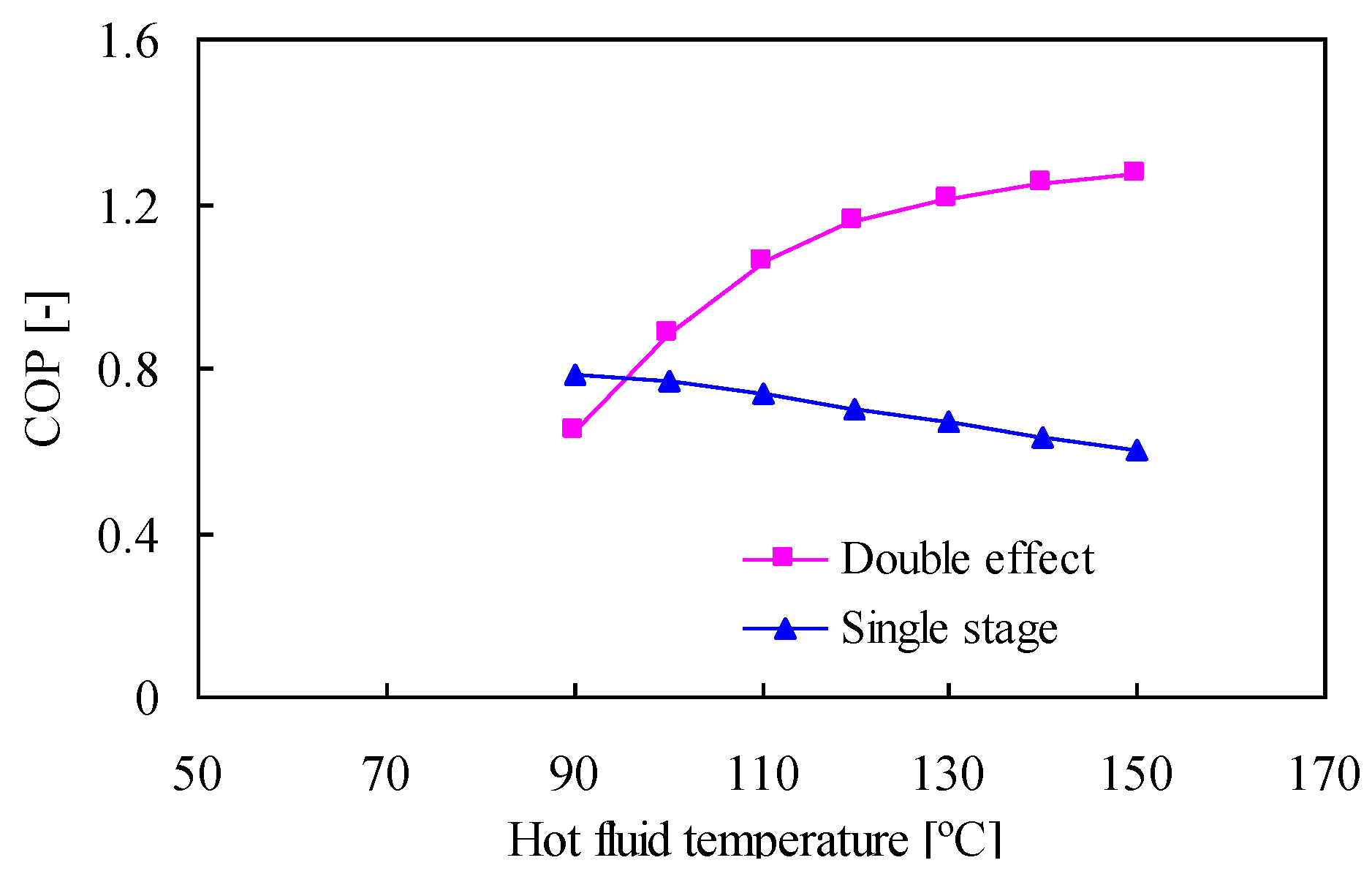
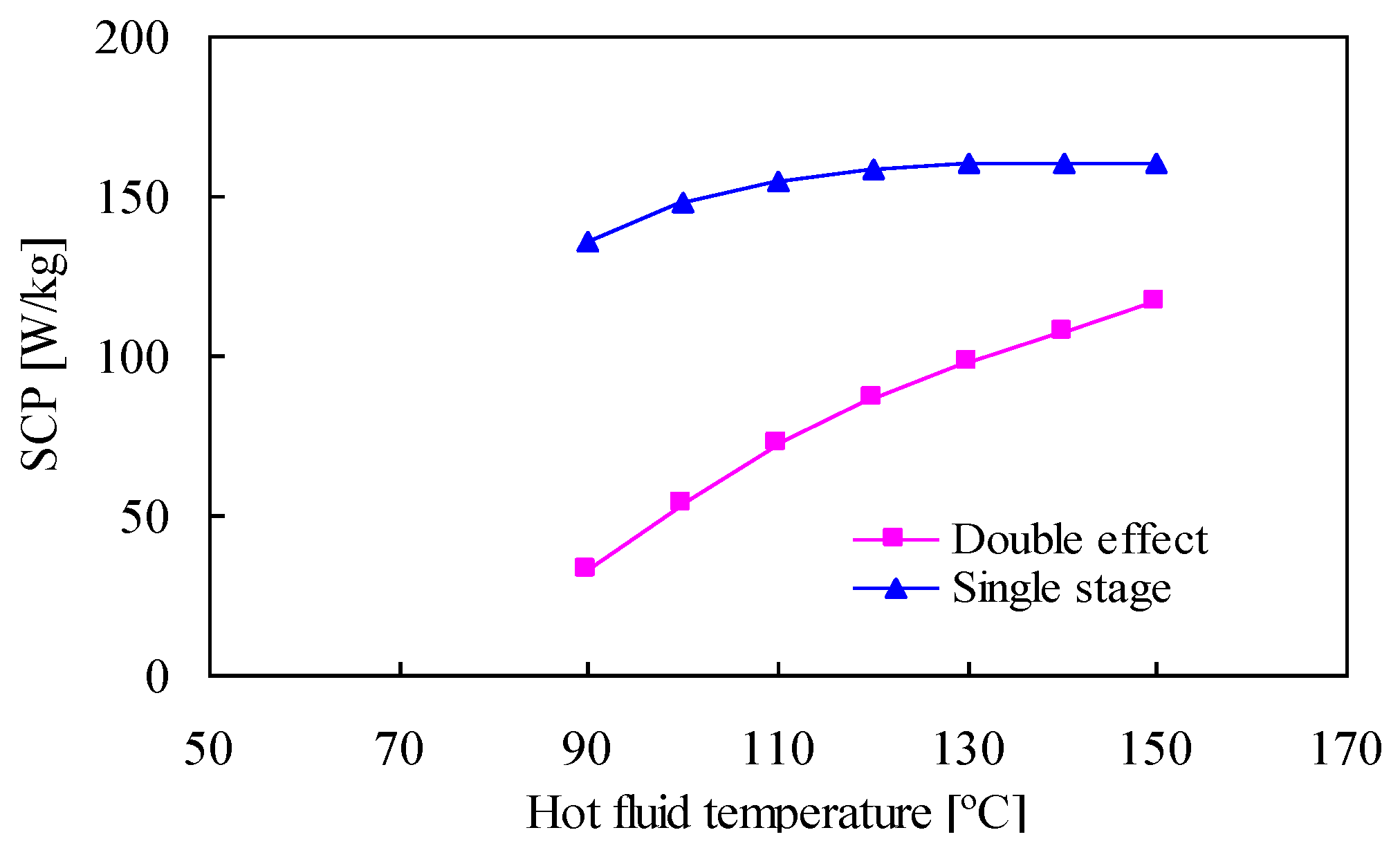
4.2. Effect of Cycle Time
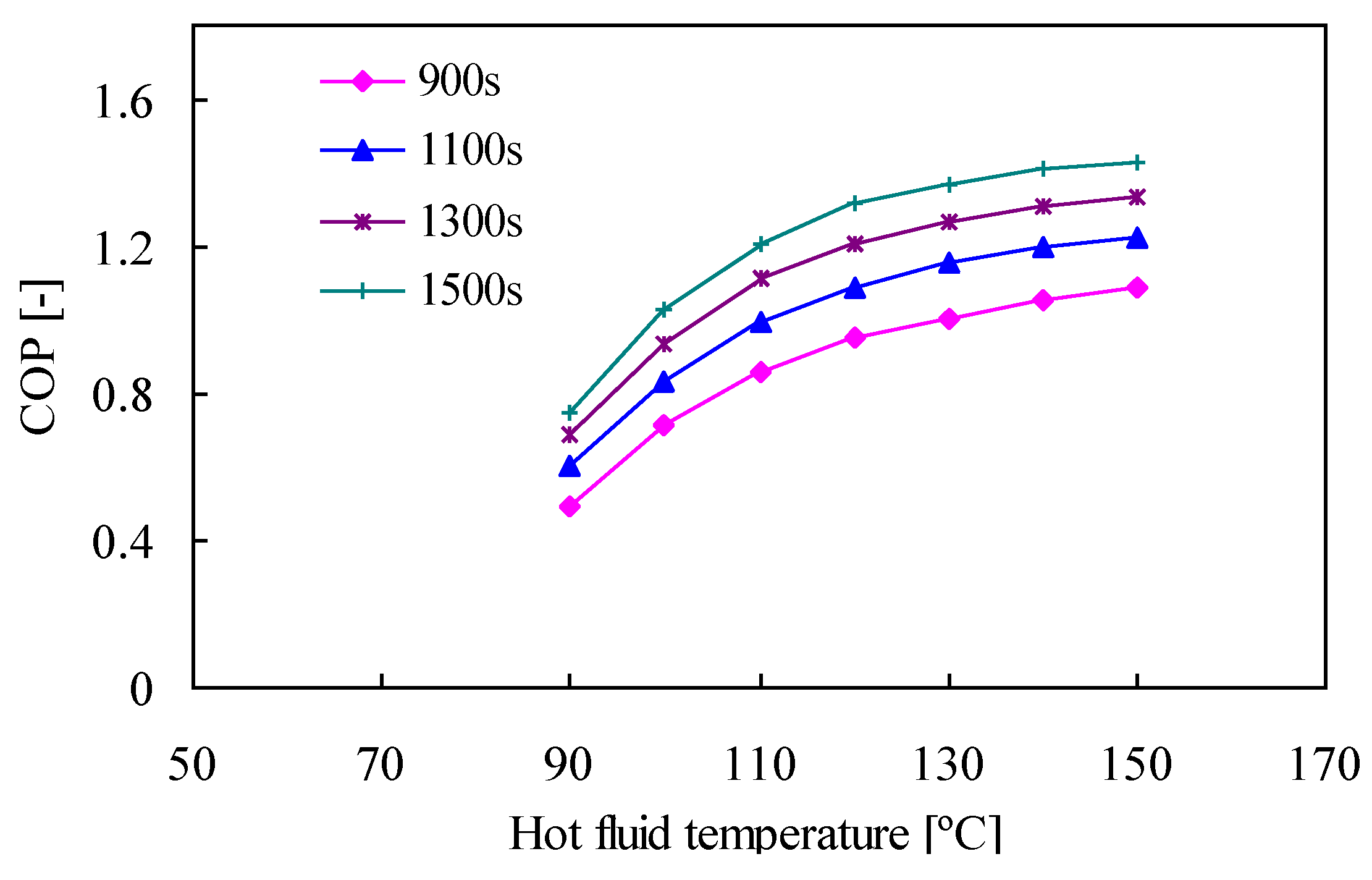
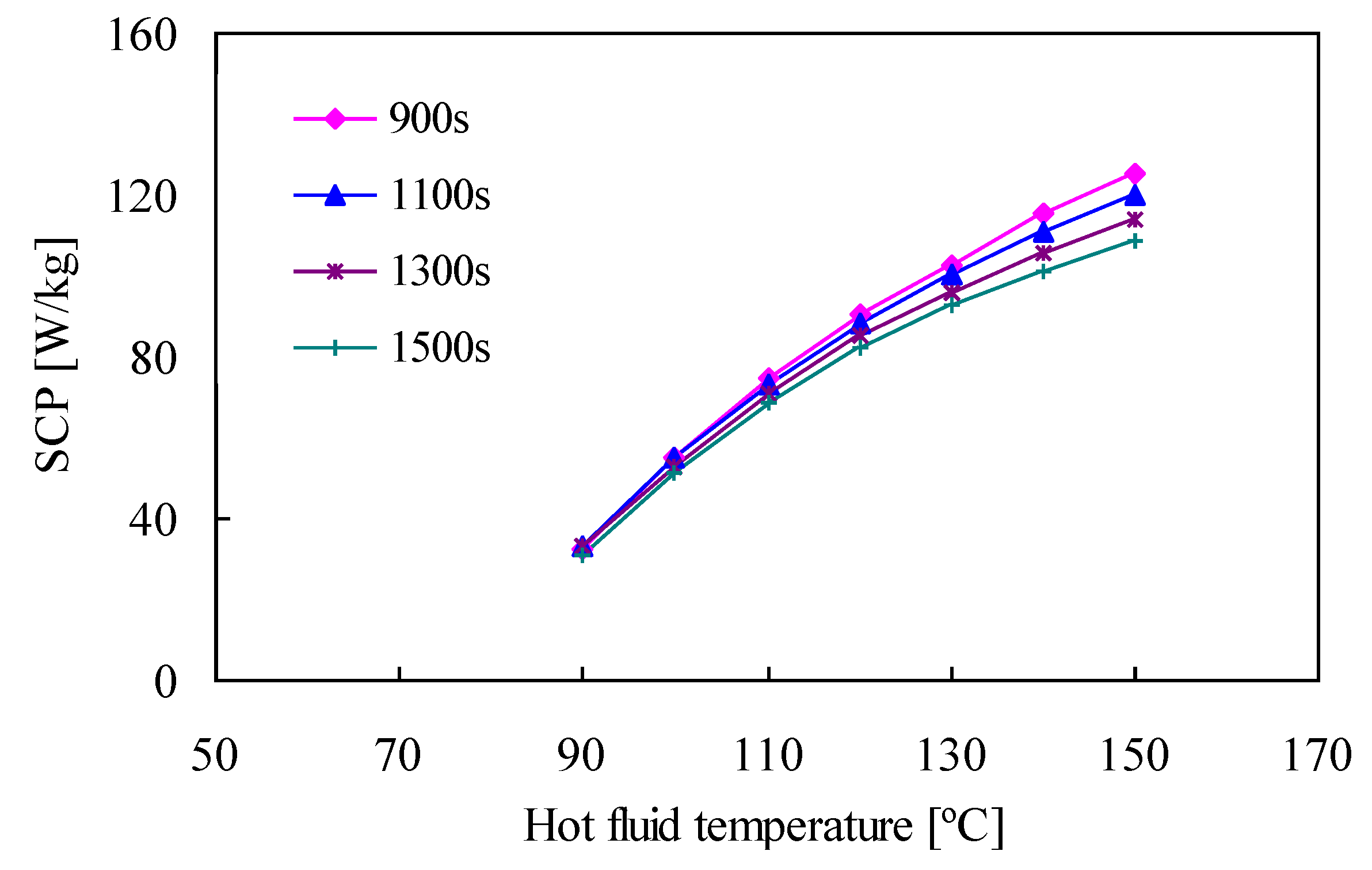
4.3. Effect of Adsorbent Mass Ratio

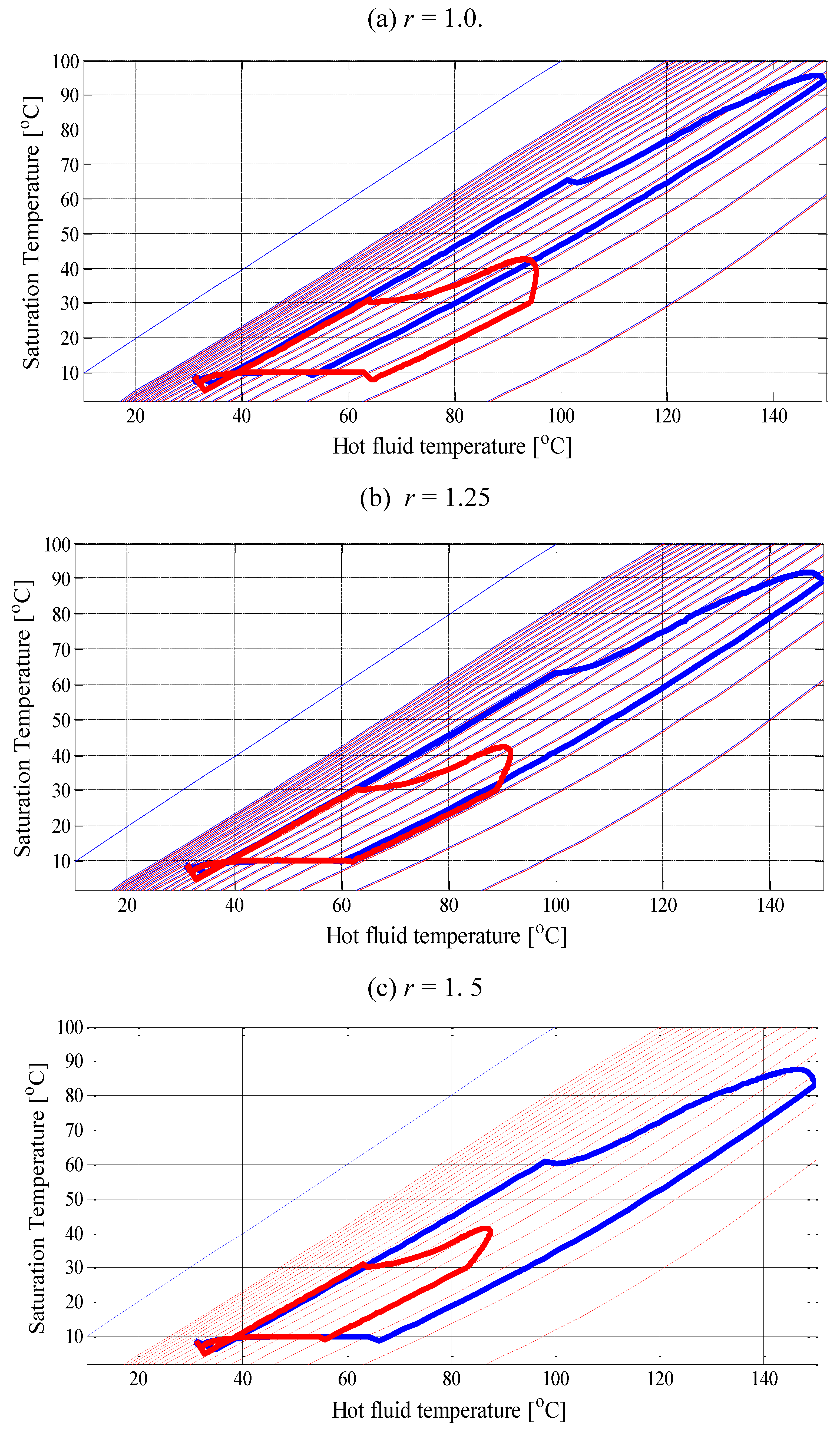
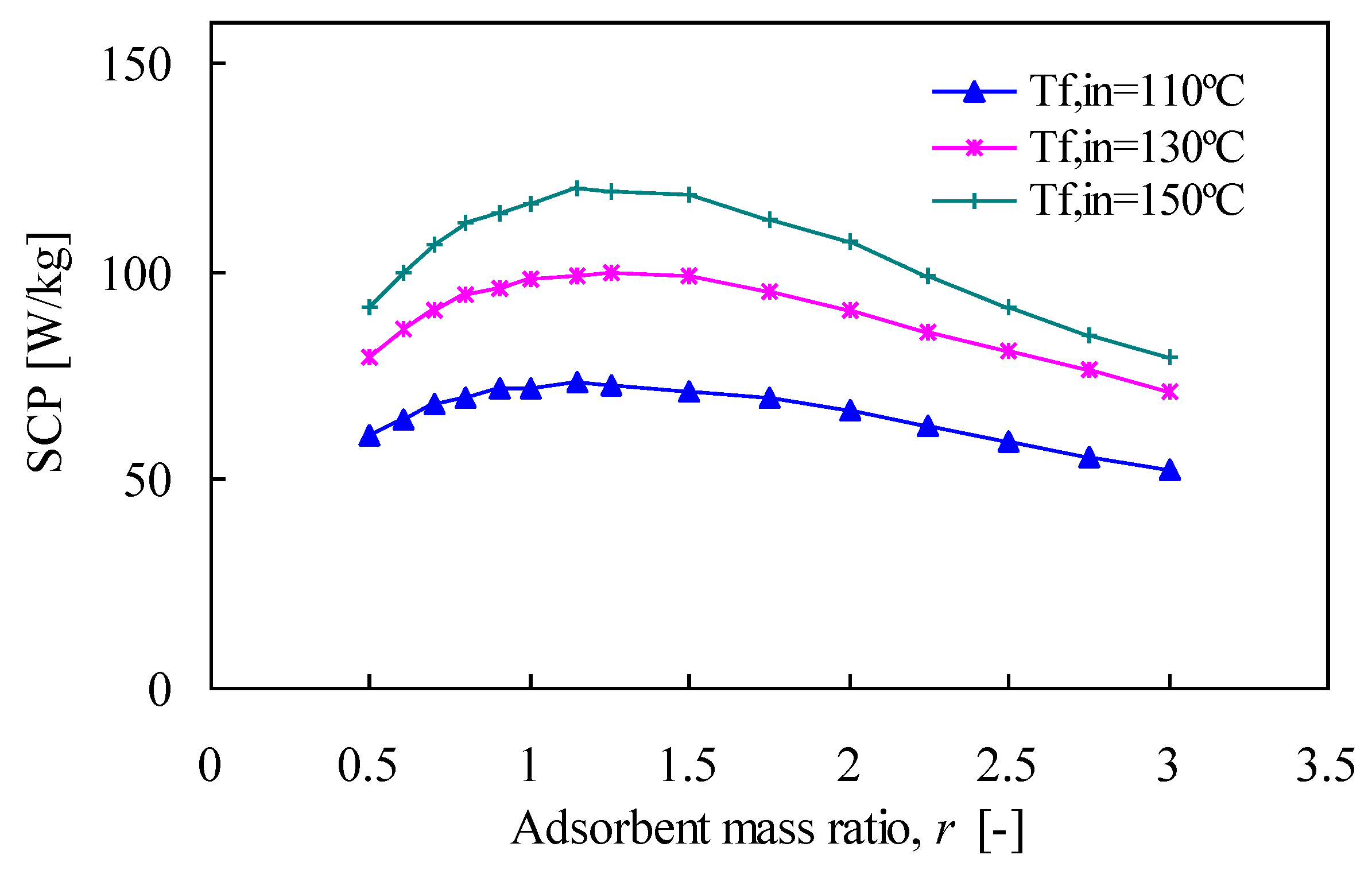
5. Conclusions
- (1)
- When the average cycle chilled water temperature is fixed at 9 °C, the double-effect cycle produces a higher COP than does the conventional single-stage cycle for driven temperatures between 100 and 150 °C. Although the SCP of the double-effect cycle is much smaller, it can be enhanced if the cycle is operated at a higher heat resource temperature.
- (2)
- The COP increases as the adsorption/desorption cycle time increases, while the SCP remains fairly stable.
- (3)
- The adsorbent mass ratio of the HTC to the LTC also affects the performance. At Tf,in = 150 °C, the COP gives the highest value when mass ratio r = 1.25.
Nomenclature
| A | area (m2) |
| C | specific heat (J kg−1 K−1) |
| Dso | surface specific heat (m2 s−1) |
| Ea | activation energy (J kg−1) |
| Lw | latent heat of vaporization (J kg−1) |
mass flow rate (kg s−1) | |
| Ps | saturated vapor pressure (Pa) |
| q | concentration (kg refrigerant/kg adsorbent) |
| q* | concentration at equilibrium (kg refrigerant/kg adsorbent) |
| T | temperature (K) |
| T | time (s) |
| U | heat transfer coefficient (W m−2 K−1) |
| W | weight (kg) |
Subscripts
| ads | adsorber or adsorption |
| cond | condenser |
| chill | chilled water |
| coolw | cooling water |
| des | desorber or desorption |
| eva | evaporator |
| f | heat transfer fluid (oil) |
| H | HTC |
| Qst | isosteric heat of adsorption (J kg−1) |
| r | adsorbent mass ratio |
| R | gas constant (J kg−1K−1) |
| hex | heat exchanger |
| hotf | hot fluid |
| hotw | hot water |
| in | inlet |
| L | LTC |
| out | outlet |
| s | silica gel |
| w | water |
References
- Lambert, M.A. Design of solar powered adsorption heat pump with ice storage. Appl. Therm. Eng. 2007, 27, 1612–1628. [Google Scholar] [CrossRef]
- Aristov, Y.I.; Restuccia, G.; Cacciola, G.; Parmon, V.N. A family of new working materials for solid sorption air conditioning system. Appl. Therm. Eng. 2002, 22, 191–204. [Google Scholar] [CrossRef]
- Kong, X.Q.; Wang, R.Z.; Wu, J.Y.; Huang, X.H.; Huangfu, Y.; Wu, D.W.; Xu, Y.X. Experimental investigation of a micro-combined cooling, heating and power system driven by a gas engine. Int. J. Refrig. 2005, 28, 977–987. [Google Scholar] [CrossRef]
- Alam, K.C.A.; Akahira, A.; Hamamoto, Y.; Akisawa, A.; Kashiwagi, T. A four-bed mass recovery adsorption refrigeration cycle driven by low temperature waste/renewable heat source. Renewable Energy 2004, 29, 1461–1475. [Google Scholar] [CrossRef]
- Ng, K.C.; Chua, H.T.; Chung, C.Y.; Loke, C.Y.; Kashiwagi, T.; Akisawa, T.; Saha, B.B. Experimental investigation of the silica gel-water adsorption isotherm characteristics. Appl. Therm. Eng. 2001, 21, 1631–1642. [Google Scholar] [CrossRef]
- Wu, J.Y.; Wang, R.Z.; Xu, Y.X. Influence of adsorption and desorption capacity on operating process for adsorption heat pump. Appl. Therm. Eng. 2002, 22, 471–476. [Google Scholar] [CrossRef]
- Dechang, W.; Jingyi, W.; Honggang, S.; Ruzhu, W. Experimental study on the dynamic characteristics of adsorption heat pumps driven by intermittent heat source at heating mode. Appl. Therm. Eng. 2005, 25, 927–940. [Google Scholar] [CrossRef]
- Gui, Y.B.; Wang, R.Z.; Wang, W.; Wu, J.Y.; Xu, Y.X. Performance modeling and testing on a heat-regenerative adsorptive reversible heat pump. Appl. Therm. Eng. 2002, 22, 309–320. [Google Scholar] [CrossRef]
- Pons, M.; Szarzynski, S. Accounting for the real properties of the heat transfer fluid in heat-regenerative adsorption cycles for refrigeration. Int. J. Refrig. 2000, 23, 284–291. [Google Scholar] [CrossRef]
- Wang, L.; Zhu, D.; Tan, Y. Heat transfer enhancement of the adsorber of an adsorption heat pump. Adsorption 1999, 5, 279–286. [Google Scholar] [CrossRef]
- Restruccia, G.; Freni, A.; Maggio, G. A zeolite-coated bed for air conditioning adsorption systems: Parametric study of heat and mass transfer by dynamic simulation. Appl. Therm. Eng. 2002, 22, 619–630. [Google Scholar] [CrossRef]
- Saha, B.B.; Boelman, E.C.; Kashiwagi, T. Computational analysis of an advanced adsorption-refrigeration cycle. Energy 1995, 20, 983–994. [Google Scholar] [CrossRef]
- Saha, B.B.; Akisawa, A.; Kashiwagi, T. Silica gel water advanced adsorption refrigeration cycle. Energy 1997, 22, 437–447. [Google Scholar] [CrossRef]
- Chua, H.T.; Ng, K.C.; Malek, A.; Kashiwagi, T.; Akisawa, A.; Saha, B.B. Modeling the performance of two-bed, silica gel–water adsorption chillers. Int. J. Refrig. 1999, 22, 194–204. [Google Scholar] [CrossRef]
- Chua, H.T.; Ng, K.C.; Wang, W.; Yap, C.; Wang, X.L. Transient modeling of a two-bed silica gel-water adsorption chiller. Int. J. Heat Mass Transfer 2004, 47, 659–669. [Google Scholar] [CrossRef]
- Shelton, S.V.; Wepfer, J.W.; Miles, D.J. Ramp wave analysis of the solid/vapor heat pump. J. Energy Resour. Technol. 1990, 112, 69–78. [Google Scholar] [CrossRef]
- Wang, R.Z. Performance improvement of adsorption cooling by heat and mass recovery operation. Int. J. Refrig. 2001, 24, 602–611. [Google Scholar] [CrossRef]
- Ng, K.C.; Wang, X.; Lim, Y.S.; Saha, B.B.; Chakarborty, A.; Koyama, S.; Akisawa, A.; Kashiwagi, T. Experimental study on performance improvement of a four-bed adsorption chiller by using heat and mass recovery. Int. J. Heat Mass Transfer 2006, 49, 3343–3348. [Google Scholar] [CrossRef]
- Douss, N.; Meunier, F. Experimental study of cascading adsorption cycles. Chemical Eng. Sci. 1989, 44, 225–235. [Google Scholar] [CrossRef]
- Liu, Y.; Leong, K.C. Numerical study of a novel cascading adsorption cycle. Int. J. Refrig. 2006, 29, 250–259. [Google Scholar] [CrossRef]
- Uyun, A.S.; Miyazaki, T.; Akisawa, A.; Kashiwagi, T. High performance cascading adsorption refrigeration cycle with internal heat recovery driven by a low grade heat source temperature. Energies 2009, 2, 1170–1191. [Google Scholar] [CrossRef]
- Marlinda; Miyazaki, T.; Ueda, Y.; Akisawa, A. Static analysis of double-effect adsorption refrigeration cycle using silica gel/water pair. Trans. Jpn. Soc. Refrig. Air Condit. Eng. 2010, 27, 57–65. (in Japanese). [Google Scholar]
- Khan, M.Z.I.; Alam, K.C.A.; Saha, B.B.; Hamamoto, Y.; Akisawa, A.; Kashiwagi, T. Parametric study of a two stage adsorption chiller using re-heat—The effect of overall thermal conductance and adsorbent mass on system performance. Int. J. Thermal. Sci. 2006, 45, 511–519. [Google Scholar] [CrossRef]
- Sakoda, A.; Suzuki, M. Fundamental study on solar powered adsorption cooling system. J. Chem. Eng. Jpn. 1984, 17, 52–57. [Google Scholar] [CrossRef]
- Hamamoto, Y.; Alam, K.C.A.; Akisawa, A.; Kashiwagi, T. Performance evaluation of a two-stage adsorption refrigeration cycle with different mass ratio. Int. J. Refrig. 2005, 28, 344–352. [Google Scholar] [CrossRef]
- Uyun, A.S.; Miyazaki, T.; Akisawa, A.; Kashiwagi, T. Performance comparison of double-effect adsorption refrigeration cycles. In Proceedings of the Asian Thermophysical Properties Conference, Fukuoka, Japan, 21–24 August 2007.
- Saha, B.B.; Boelman, E.C.; Kashiwagi, T. Computational analysis of an advanced adsorption-refrigeration cycle. Energy 1995, 20, 983–994. [Google Scholar] [CrossRef]
© 2010 by the authors; licensee MDPI, Basel, Switzerland. This article is an open access article distributed under the terms and conditions of the Creative Commons Attribution license (http://creativecommons.org/licenses/by/3.0/).
Share and Cite
Marlinda; Uyun, A.S.; Miyazaki, T.; Ueda, Y.; Akisawa, A. Performance Analysis of a Double-effect Adsorption Refrigeration Cycle with a Silica Gel/Water Working Pair. Energies 2010, 3, 1704-1720. https://doi.org/10.3390/en3111704
Marlinda, Uyun AS, Miyazaki T, Ueda Y, Akisawa A. Performance Analysis of a Double-effect Adsorption Refrigeration Cycle with a Silica Gel/Water Working Pair. Energies. 2010; 3(11):1704-1720. https://doi.org/10.3390/en3111704
Chicago/Turabian StyleMarlinda, Aep Saepul Uyun, Takahiko Miyazaki, Yuki Ueda, and Atsushi Akisawa. 2010. "Performance Analysis of a Double-effect Adsorption Refrigeration Cycle with a Silica Gel/Water Working Pair" Energies 3, no. 11: 1704-1720. https://doi.org/10.3390/en3111704
APA StyleMarlinda, Uyun, A. S., Miyazaki, T., Ueda, Y., & Akisawa, A. (2010). Performance Analysis of a Double-effect Adsorption Refrigeration Cycle with a Silica Gel/Water Working Pair. Energies, 3(11), 1704-1720. https://doi.org/10.3390/en3111704





